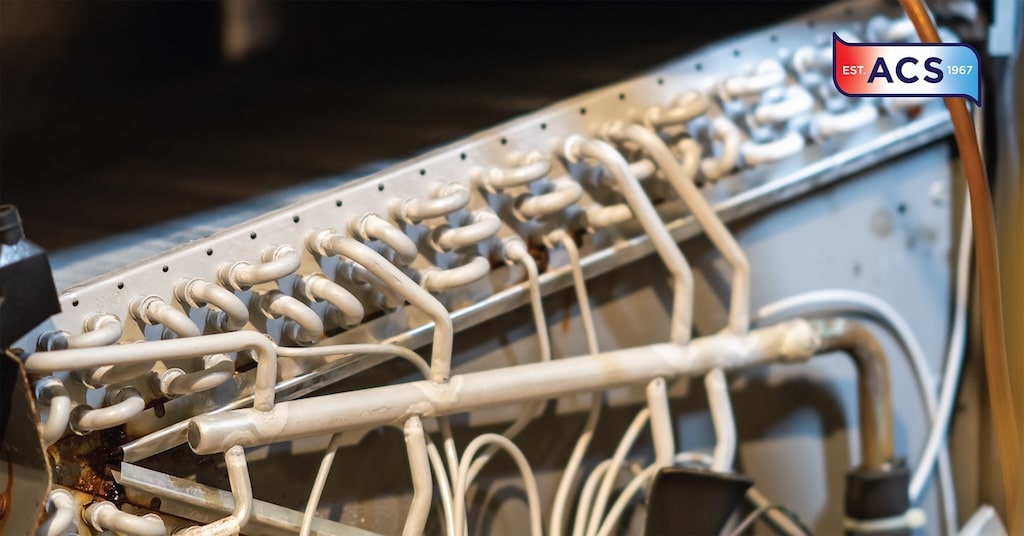As a busy home or business owner, the last thing on your mind might be your HVAC system and its functional components. However, understanding the intricacies of your system and its operations can help you maintain your indoor air quality and make fixing problems more manageable.
Looking to brush up on your HVAC knowledge? At ACS, we offer exclusive industry insight and premium residential and commercial HVAC maintenance to keep your heating and cooling consistent all year. Below, we’ve compiled a list of the most critical components that make up your residential or commercial HVAC system.
1. Heat Exchanger
Although this may be the first time you’ve heard of them, heat exchangers play a crucial part in keeping your space comfortable during colder months. Found in both electric and gas furnaces, heat exchangers absorb heat to warm your indoor air. Your thermostat activates the heat exchanger once the indoor temperature drops below your set heating point.
Heat exchangers contain temperature-resistant stainless steel to prevent cracks, leaks, and other damages. However, regular furnace maintenance is still crucial to ensure your heat exchanger is in good condition. A broken heat exchanger can put you at risk of hazardous carbon monoxide leaks, which could result in severe medical consequences. By installing gas detectors in your home and scheduling routine HVAC maintenance on your furnace, you can maintain your heat exchanger functional and safe.
2. Blower Motor
Once your heat exchanger heats the air to your desired temperature, the blower motor is next up to bat. The blower motor blows the warm air through your air ducts and distributes it throughout your space. However, the blower motor doesn’t stop there. As the warm air circulates through your home, the blower motor continues to work even after the combustion ends.
If you’re looking to cut costs, consider a variable-speed blower motor. These motors will operate at varying speeds to control airflow throughout your space. Variable speed blower motors are quiet and more efficient than other models, saving you money on energy bills and optimizing your HVAC system’s performance.
3. Combustion Chamber
Combustion chambers are a critical component of your furnace. Also called burners, combustion chambers mix fuel and oxygen to create heat. Your furnace’s pilot light or glow stick will then ignite the mixture and burn the controlled fire. However, this process will vary depending on your furnace model.
Glow sticks are used in electric furnaces and can switch on automatically. Meanwhile, pilot lights must be manually relit if they go out. Pilot lights are commonly found in older systems that may be on their last leg. If your system still uses a pilot light for its combustion, it may be time to call your local air specialist for a new furnace installation.
4. Compressor or Condenser Coil
The compressor or condenser oil is found in your air conditioning unit. Typically found outside of the home or on the rooftop, compressors are responsible for releasing heat from inside your house into the outdoor environment. As this process occurs, the condenser cools your home when it compresses and condenses refrigerant from a heated gas into a cold liquid. Your blower fan then distributes over the condenser coil to disperse air and quickly cool the refrigerant. Lastly, your HVAC system will send the liquor refrigerant through an aluminum or copper line or tube to your evaporator coil.
Because your compressor or condenser coil is outside, it’s easily susceptible to damage and debris. Keep an eye out for fallen leaves, grass clippings, dirt, and other debris that could dirty or damage your compressor. We recommend rinsing your system with a hose at least once a year to maintain its cleanliness and function.
5. Evaporator Coil
Like a compressor or condenser coil, evaporator coils play a vital role in cooling your home or business. The evaporator coil brings refrigerant to your system’s expansion valves. These valves then convert the liquid refrigerant into a gaseous state by spraying them through tiny nozzles. Subsequently, the gas will absorb heat from inside your space and decrease the overall temperature.
Evaporator coils can be very susceptible to mold and mildew growth through condensation. This mold growth significantly impacts your indoor air quality and can put your household at risk of various sinus infections. By monitoring your AC unit and scheduling regular HVAC maintenance, you can avoid mold and pollutant buildup and maintain indoor air quality all year.
If you’re searching for residential or commercial HVAC maintenance, you can count on ACS to deliver nothing but the best. Our experienced technicians are equipped to create the healthiest and safest indoor environment possible for your household or business. Connect with our team today for premium HVAC installations and repairs in Covington, Milledgeville, and surrounding areas.



